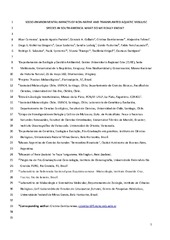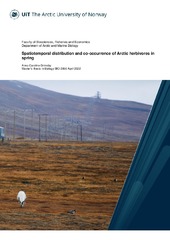Institutt for arktisk og marin biologi: Nye registreringer
Viser treff 421-440 av 2086
-
South American terrestrial Gastropoda in the collection of the Auckland War Memorial Museum
(Journal article; Tidsskriftartikkel; Peer reviewed, 2023-03-10)The catalogued collection of South American terrestrial gastropods, including the Caribbean ABC islands and Trinidad & Tobago, of the Auckland War Memorial Museum (AM), New Zealand, is discussed here. In total, 264 specimen lots from South America were found in the AM collection, including eight type lots. Twelve of the specimens represent new geographic distribution data, including the first ... -
Socio-environmental impacts of non-native and transplanted aquatic mollusc species in South America. What do we really know?
(Journal article; Tidsskriftartikkel; Peer reviewed, 2023-02-15)The impacts of biological invasions remain poorly known for some habitats, regions and taxa. To date, there has been no comprehensive effort to review and synthesize the impacts of invasive mollusc species in South America. In this paper, we provide a synoptic view on what is known on documented socio-ecological impacts of aquatic no-native mollusc species (NNMS) and transplanted mollusc species ... -
Arctic terrestrial biodiversity status and trends: A synopsis of science supporting the CBMP State of Arctic Terrestrial Biodiversity Report
(Journal article; Tidsskriftartikkel; Peer reviewed, 2020-01-18)This review provides a synopsis of the main findings of individual papers in the special issue <i>Terrestrial Biodiversity in a Rapidly Changing Arctic</i>. The special issue was developed to inform the <i>State of the Arctic Terrestrial Biodiversity Report</i> developed by the Circumpolar Biodiversity Monitoring Program (CBMP) of the Conservation of Arctic Flora and Fauna (CAFF), Arctic Council ... -
Spatiotemporal distribution and co-occurrence of Arctic herbivores in spring
(Master thesis; Mastergradsoppgave, 2022-04-19)Biotic interactions play an important role in the structure and dynamics of food-webs and may drive the spatial distribution of species. In the Arctic, spring snow-cover limits the availability of resources at a critical time for resident and migratory herbivores, which could lead to resource competition. This study takes a first step towards understanding the potential for competition between the ... -
Establishment of killer whale (Orcinus orca) primary fibroblast cell cultures and their transcriptomic responses to pollutant exposure
(Journal article; Tidsskriftartikkel; Peer reviewed, 2023-04-02)Populations of killer whale (Orcinus orca) contain some of the most polluted animals on Earth. Yet, the knowledge on effects of chemical pollutants is limited in this species. Cell cultures and in vitro exposure experiments are pertinent tools to study effects of pollutants in free-ranging marine mammals. To investigate transcriptional responses to pollutants in killer whale cells, we collected skin ... -
Life-cycle analysis of an endangered migratory goose to assess the impact ofconservation actions on population recovery
(Journal article; Tidsskriftartikkel; Peer reviewed, 2023-03-29)Evaluating the effectiveness of conservation actions is challenging for migratory species because a population can be impacted anywhere along its route. Conservation actions for the critically endangered Fennoscandian lesser white-fronted goose population include culling of red foxes in the breeding area and habitat improvements and reduction of illegal hunting in the non-breeding areas. One goal ... -
Skogens helsetilstand i Norge. Resultater fra skogskadeovervåkingen i 2021
(Research report; Forskningsrapport, 2023-03-08)Skogens helsetilstand påvirkes i stor grad av klima og værforhold, enten direkte ved tørke, frost og vind, eller indirekte ved at klimaet påvirker omfanget av soppsykdommer og insektangrep. Klimaendringene og den forventede økningen i klimarelaterte skogskader gir store utfordringer for forvaltningen av framtidas skogressurser. Det samme gjør invaderende skadegjørere, både allerede etablerte arter ... -
Panel-based Assessment of Ecosystem Condition of Norwegian Barents Sea Shelf Ecosystems - Appendices
(Research report; Forskningsrapport, 2023-03-16) -
Panel-based Assessment of Ecosystem Condition of Norwegian Barents Sea Shelf Ecosystems
(Research report; Forskningsrapport, 2023-03-16)The System for Assessment of Ecological Condition, coordinated by the Norwegian Environment Agency, is intended to form the foundation for evidence-based assessments of the ecological condition of Norwegian terrestrial and marine ecosystems not covered by the EU Water Framework Directive. The reference condition is defined as “intact ecosystems”, i.e., a condition that is largely unimpacted by modern ... -
Waters that matter: How human-environment relations are changing in high-Arctic Svalbard
(Journal article; Tidsskriftartikkel; Peer reviewed, 2022-12-20)There is scientific consensus that the archipelago of Svalbard is warming up faster than other parts of the planet. People who live in or regularly visit this part of the European high Arctic observe and experience these changes in a subjective and relational manner. This article illustrates how perceptions of environmental change are enmeshed with our ways of interacting with water(s) and dwelling ... -
Modelling the spatial shifts of functional groups in the Barents Sea using a climate-driven spatial food web model
(Journal article; Tidsskriftartikkel; Peer reviewed, 2023-03-28)We built a dynamic, spatial food web model for the Barents Sea, developed with Ecospace by including species’ habitat requirements and ecological interactions. The model was used to test the spatial shifts of different functional groups due to warming. We compared model-predicted and field-surveyed biomass of functional groups (FGs) spatial distributions in relatively cold and warm years. The ... -
Global patterns and drivers of ecosystem functioning in rivers and riparian zones
(Journal article; Tidsskriftartikkel; Peer reviewed, 2019-01-09)River ecosystems receive and process vast quantities of terrestrial organic carbon, the fate of which depends strongly on microbial activity. Variation in and controls of processing rates, however, are poorly characterized at the global scale. In response, we used a peer-sourced research network and a highly standardized carbon processing assay to conduct a global-scale field experiment in greater ... -
Chronological changes in soil biogeochemical properties of the glacier foreland of Midtre Lovénbreen, Svalbard, attributed to soil-forming factors
(Journal article; Tidsskriftartikkel; Peer reviewed, 2022-02-21)Glacier forelands provide an excellent opportunity to investigate vegetation succession and soil development along the chronosequence; however, there are few studies on soil biogeochemical changes from environmental factors, aside from time. This study aimed to investigate soil development and biogeochemical changes in the glacier foreland of Midtre Lov ́enbreen, Svalbard, by considering various ... -
Feasibility of active handheld NDVI sensors for monitoring of lichen ground cover
(Journal article; Tidsskriftartikkel; Peer reviewed, 2023-03-04)Vegetation indices are corner stones in vegetation monitoring. However, previous field studies on lichens and NDVI have been based on passive sensors. Active handheld sensors, with their own light sources, enables high- precision monitoring under variable ambient conditions. We investigated the use of handheld sensor NDVI for monitoring pale lichen cover across three study sites from boreal heathlands ... -
Sub-arctic mosses and lichens show idiosyncratic responses to combinations of winter heatwaves, freezing and nitrogen deposition
(Journal article; Tidsskriftartikkel; Peer reviewed, 2023-02-25)Arctic ecosystems are increasingly exposed to extreme climatic events throughout the year, which can affect species performance. Cryptogams (bryophytes and lichens) provide important ecosystem services in polar ecosystems but may be physiologically affected or killed by extreme events. Through field and laboratory manipulations, we compared physiological responses of seven dominant sub-Arctic ... -
Raising offspring increases ageing: Differences in senescence among three populations of a long-lived seabird, the Atlantic puffin
(Journal article; Tidsskriftartikkel; Peer reviewed, 2023-01-12)1. Actuarial senescence, the decline of survival with age, is well documented in the wild. Rates of senescence vary widely between taxa, to some extent also between sexes, with the fastest life histories showing the highest rates of senescence. Few studies have investigated differences in senescence among populations of the same species, although such variation is expected from population-level ... -
The Norwegian philosopher Peter Wessel Zapffe(1899-1990) and the Book of Job
(Journal article; Tidsskriftartikkel; Peer reviewed, 2022)https://www.dknvs.no/publikasjoner/skrifter/ -
Recent evolution of ancient Arctic leech relatives: systematics of Acanthobdellida
(Journal article; Tidsskriftartikkel; Peer reviewed, 2022-07-16)Acanthobdellida gnaw into the sides of salmonid fishes in frigid Arctic lakes and rivers, latching on with fearsome facial hooks. Sister to leeches, they are an ancient lineage with two described species. Unfortunately, Acanthobdellida are rarely collected, leading to a paucity of literature despite their unique morphology. Populations range from Eurasia to Alaska (USA), but few specimens of ... -
Mantle source heterogeneity in a Neoproterozoic back-arc basin: Geochemical and thermodynamic modeling of the volcanic section of Wadi Ghadir ophiolite, Egypt
(Journal article; Tidsskriftartikkel; Peer reviewed, 2021-12-02)Wadi Ghadir ophiolite in the Egyptian Eastern Desert, which forms the northern part of the Nubian Shield, is considered as one of the best-preserved segments of the Neoproterozoic oceanic lithosphere on Earth. Primary melt calculations and thermodynamic modeling of new geochemical data for the Wadi Ghadir pillow lavas and dike complexes, integrated with comprehensive petrographic investigations, are ... -
Lipids and diapause in Calanus spp. in a high-Arctic fjord: state-dependent strategies? Tracking lipids through the polar night
(Master thesis; Mastergradsoppgave, 2010-11-15)Calanus copepods C. finmarchicus, C. glacialis and C. hyperboreus are keystone species in the Arctic marine ecosystem, constituting 70-90% of the zooplankton biomass. In high latitudes, the growing season is short and unpredictable, and the winter long and unproductive. These species have adapted flexible life histories, lipid accumulation, and a state of deep-water diapause to survive. Winter ...


 English
English norsk
norsk


















